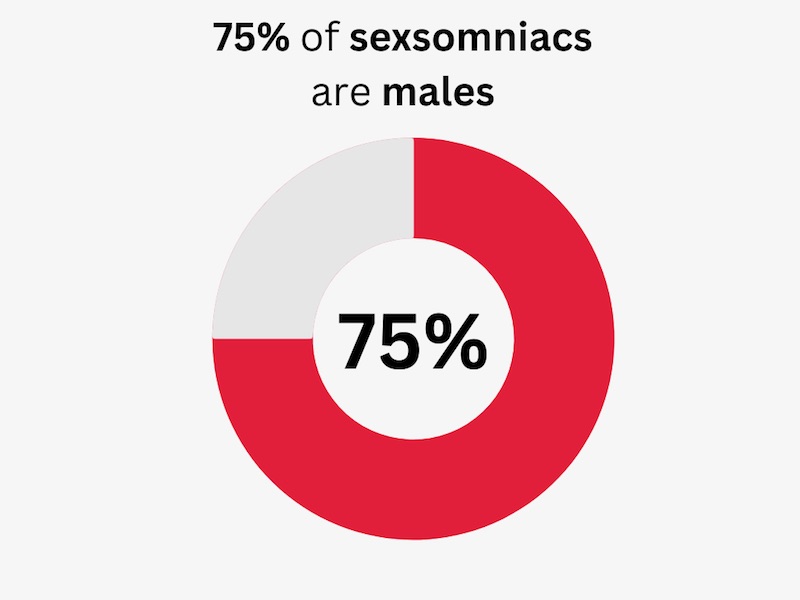We’ve all heard of sleepwalking, but have you ever heard of sleep sex?
Known medically as sexsomnia, sleep sex is a rare yet notably common condition characterized by unconscious and unintentional sexual behavior.
Below, we’re exploring everything there is to know about sexsomnia, including how common it is, what causes it, and more.
Let’s dive in!

Key Sexsomnia Stats
- The first documented case of sexsomnia was reported in 1986.
- 2% to 6% of the general adult population suffer from sexsomnia.
- 75% of sexsomniacs are men.
- 82% of those accused of sleep-related sexual assaults were male.
- One study found that individuals who reported sexsomnia were twice as likely to admit previous drug use.
- Roughly 14% of sexsomnia cases end up in court.
- Men are three times more likely to present with sexsomnia than women.
- Male sexsomniacs are more likely to be sexually aggressive.
- Women sexsomniacs are more likely to moan or masturbate.
- 4 of 832 of one study’s participants expressed concerns over sexsomnia.
- As of 2015, only 94 cases of sexsomnia had been reported.
- Sexsomnia may lead to confusion, increased stress, anxiety, fear, or depression.
- Sexsomnia disrupts NREM sleep, which may cause chronic fatigue and sleep deprivation, further exacerbating the condition.
- Because of the embarrassing nature of the condition, many cases of sexsomnia likely go unreported and undiagnosed.
- In one-third of court cases, victims and bystanders reported violence or aggressive behavior.
What is Sexsomnia?
How Common is Sexsomnia?
What Causes Sexsomnia?
Facts About Sexsomnia: Sexual Intercourse During Sleep
Is Sexsomnia A thing?
The Implications Of Sleep Sex
Court Cases Involving Sexsomniacs
What Is Sexsomnia?
Similar to sleepwalking or talking in one’s sleep, sexsomnia is a parasomniac condition where an individual engages in sexual activity while asleep.
- Sexsomnia is characterized by moaning, vocalizations (dirty talk), masturbation, sexual advances towards a bed partner, penetrative intercourse, thrusting, and even orgasm, all without the person being aware of their actions.
- An estimated 1 in 10 Americans suffer from parasomnia, which includes sleepwalking or talking, sleep terrors, sleep eating, sleep paralysis, or nightmare disorders.
- While it’s easy to confuse them, sexsomnia is entirely different from nocturnal emissions (wet dreams), which younger males often experience during puberty, and erotic dreaming in adults.
How Common Is Sexsomnia?
- One Canadian study found that about 8% of those involved presented sexsomnia-related behavior.
- 73% of patients diagnosed with sexsomnia have a history of other parasomnias.
- 2% to 6% of the general adult population suffer from sexsomnia.
- As of 2015, only 94 cases of sexsomnia had been reported.
- Because of the embarrassing nature of the condition, many cases of sexsomnia likely go unreported and undiagnosed.
- An individual with sexsomnia may not even be aware that they have it.
- One study found 75% of participants exhibiting sexsomnic activity to be male.
- Men are three times more likely to present with sexsomnia than women.
- Sexsomnia is predominant in younger males who also present with other parasomnias during non-rapid eye movement sleep, such as bruxism, restless leg syndrome, or talking in their sleep.
- Symptoms of the conditions are more pronounced in males.
- Some researchers have noted that male sexsomniacs are more likely to be sexually aggressive during an episode.
- Women are more likely to moan or masturbate during an episode of sexsomnia.
What Causes Sexsomnia?
Because so many cases are unreported and undiagnosed, extensive research has yet to be conducted to understand better what causes the condition.
Experts agree that almost anything that wakes a person up may trigger an episode.
However, many other factors have been linked to sexsomnia-related behavior, including:
- Having a history of traumatic psychological stress or sexual abuse.
- A history of alcoholism or recreational drug use.
- Current and ongoing alcohol or drug use.
- Head injuries and physical trauma.
- Heightened levels of stress or anxiety.
- Chronic fatigue and poor sleep patterns.
- Sleep deprivation.
- Working shift work, mainly evenings and graveyard shifts may increase the incidence of sexsomnia.
- Travel and jet lag can also disrupt sleep patterns and trigger sexsomnia.
- The use of medications, especially over-the-counter sleeping aids.
- Sleep apnea, heartburn, indigestion (GERD), and restless leg syndrome have also been linked to sexsomnia.
- Existing medical conditions, such as chronic migraines, epilepsy, colitis, and Crohn’s disease, may also increase susceptibility to sexsomnia-related behavior.
Facts About Sexsomnia: Sexual Intercourse During Sleep
- Individuals who suffer from sexsomnia are known as sexsomniacs.
- Only 4 of 832 of one study’s participants expressed concerns over sexsomnia.
- One study found that individuals who reported sexsomnia were twice as likely to admit previous drug use.
- Sexsomnia is also known as sexual behavior during sleep (SBS), sleep sex, and sleepwalking sex.
- The first documented case of sexsomnia was reported in 1986.
- Episodes typically occur while an individual is in deep, non-rapid eye movement (NREM) sleep.
- However, sexsomnia episodes may also occur during rapid eye movement (REM) sleep.
- Typically, sexsomniacs perform activities that are within the bounds of their usual sexual behavior.
- But they may also act in ways that are outside of their normal behavior.
- Video-polysomnography—which monitors brainwave activity, heart and respiration rates, and leg and eye movement—is traditionally used to study and diagnose patients exhibiting symptoms of sexsomnia.
- Serotonin reuptake inhibitors have been used to treat sexsomnia successfully.
- An individual experiencing a sexsomnia episode may appear awake with open eyes and a glassy, vacant start upon their face.
- Continuous positive airway pressure, or CPAP machines—a device used to treat patients with sleep apnea—may reduce the occurrence of sexsomnia.
- Medications and healthy sleep habits are also prescribed as sexsomnia treatments.
- Sexsomniacs do not recall their actions before, during, or after an episode.
Is Sexsomnia A thing?
Yes! Sexsomnia is a documented clinical sleep and psychiatric disorder, included in most versions of the Diagnostic and Statistical Manual of Mental Disorders and the International Classification of Sleep Disorders.
Therefore, it must be appropriately diagnosed, monitored, and treated whenever possible.
- Sexsomnia is only one of many parasomnias—relatively rare conditions where a person performs activities while in a state between being asleep and awake.
The Implications Of Sleep Sex
Sexsomnia can broadly affect the person with the condition and those around them.
On the lighter side, most of the time, sexsomnia or sleep sex doesn’t cause any physical harm to the patient or their loved ones. But:
- Individuals may be embarrassed or ashamed when they discover what they’ve done.
- Sexsomnia may lead to confusion, increased stress, anxiety, fear, or depression.
This is especially true since sexsomniacs generally have no intentions or recollections of their actions.
On the other hand, in some more severe cases, sexsomniacs have been known to be sexually aggressive toward others, which may result in sexual assault, nonconsensual sex, or other physical, mental, or emotional harm.
As we’ll see in a minute, some cases of sexsomnia have even ended up in court!
But these aren’t the only implications of sleepwalking sex.
- Non-rapid eye movement (NREM) sleep is vital for our bodies to repair damage from oxidation, regrow tissue, grow bones and muscles, and support proper immune health.
- Sexsomnia disrupts NREM sleep, which may cause chronic fatigue and sleep deprivation, further exacerbating the condition.
- Altered sleep patterns can negatively impact an individual’s productivity and work output.
If you or any of your loved ones are showing signs or symptoms of sexsomnia, it’s crucial to consult a doctor or healthcare professional to learn the best way to treat the condition.
- Sleeping alone or in a locked room can prevent sexsomnia behavior from disturbing or causing harm to others.
Court Cases Involving Sexsomniacs
Because of the unconscious and unintentional aspects of sexsomnia, the condition often raises the question of consent.
There are several documented cases of sexsomnia-related sexual assaults going to court.
- In one court case related to rape, the defendant claimed sexsomnia as their primary defense.
- From across nine different countries, 82% of those accused of sleep-related sexual assaults were male.
- More than 97% of those charged with a sexsomnia-related sex crime used amnesia as part of their defense.
- In one-third of court cases, victims and bystanders reported violence or aggressive behavior.
- Roughly 14% of sexsomnia cases end up in court.
- In a Canadian court case, R vs. Luedecke, sane automatism was used as the accused’s defense.
Premeditation and intent are two of the most critical aspects of determining whether an individual is guilty of a crime.
But because a sexsomniac is unconscious, proving their intent and guilt is nearly impossible, making it very challenging to prosecute offenders.
Judges and jurors may examine the medical history of the accused and other evidence to establish intent.
But determining responsibility remains a highly complex and controversial task for lawmakers.
Let’s take a look at a few other reasons why it can be hard to convict someone of a sexsomnia-related sex crime:
- Even when guilt is established, it can be challenging for authorities to determine an adequate sentence for the crime.
- Despite being unconscious, an individual is still legally responsible for their actions.
- Automatism—an unconscious state of mind—has sometimes been used to defend against sexual assault related to sexsomnia.
- Pleading insanity or partial insanity are also defenses used by those convicted of sexsomnia-related sex crimes.
- The use of drugs, alcohol, sleep deprivation, untreated or undiagnosed sleep disorders, and the concept of criminal behavior masquerading as a medical disorder are all factors that make litigation extremely complicated.
- Béjot, Y., Juenet, N., Garrouty, R., Maltaverne, D., Nicolleau, L., Giroud, M., & Didi-Roy, R. (2010). Sexsomnia: An uncommon variety of parasomnia. Clinical Neurology and Neurosurgery, 112(1), 72–75. https://doi.org/10.1016/j.clineuro.2009.08.026
- Holoyda, B. J., Sorrentino, R. M., Mohebbi, A., Fernando, A. T., & Friedman, S. H. (2021). Forensic Evaluation of Sexsomnia. Journal of the American Academy of Psychiatry and the Law Online. https://pubmed.ncbi.nlm.nih.gov/33579735/
- Is Sexsomnia Real — and Could You Have It and Not Know It? (2022, August 15). Cleveland Clinic. https://health.clevelandclinic.org/sexsomnia/
- Kim, D. S., Foster, B. E., Scott, J. A., Rizzo, M. M., Collen, J. F., & Soca, R. (2021). A rare presentation of sexsomnia in a military service member. Journal of Clinical Sleep Medicine: JCSM: Official Publication of the American Academy of Sleep Medicine, 17(1), 107–109. https://doi.org/10.5664/jcsm.8832
- Muza, R., Lawrence, M., & Drakatos, P. (2016). The reality of sexsomnia. Current Opinion in Pulmonary Medicine, 22(6), 576–582. https://doi.org/10.1097/mcp.0000000000000321
- Parasomnias. (n.d.). Yale Medicine. https://www.yalemedicine.org/conditions/parasomnias
- Pyrgelis, E.-S., Mavridis, I. N., Wimalachandra, W. S. B., Meliou, M., & Agapiou, E. (2021). Sexsomnia: A Rare Parasomnia With Important Medicolegal Aspects. Sleep and Vigilance, 5(1), 29–34. https://doi.org/10.1007/s41782-021-00139-3
- Sleep Sex: Understanding Sexsomnia. (2017, June 7). Healthline. https://www.healthline.com/health/sleep-sex#incidence
- Sleep sex: What to know about sexsomnia. (2017, December 28). Www.medicalnewstoday.com. https://www.medicalnewstoday.com/articles/320448#overview
- Study Finds that Sexsomnia is Common in Sleep Center Patients. (2010, May 12). American Academy of Sleep Medicine – Association for Sleep Clinicians and Researchers. https://aasm.org/study-finds-that-sexsomnia-is-common-in-sleep-center-patients/

Review or Comment